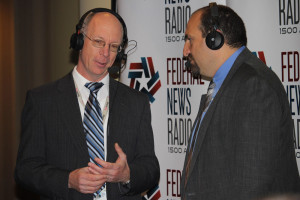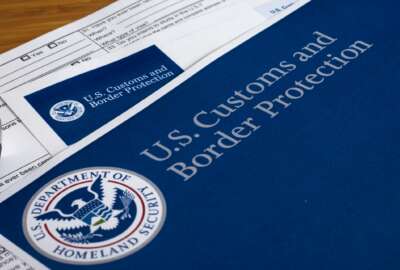For CBP, supply chain risk is much more than just cybersecurity
Mark Borkowski, the assistant commissioner in the Office of Acquisition and the chief acquisition officer at CBP in the Homeland Security Department said he is...
When U.S. Customs and Border Protection considers its supply chain, the range of products and services is almost endless.
One day they might be buying food and clothes for migrants. The next day, CBP may be buying unmanned aerial vehicles to protect the border. And the next day, CBP may be buying IT systems to process forms.
Mark Borkowski, the assistant commissioner in the Office of Acquisition and the chief acquisition officer at CBP in the Department of Homeland Security, said at a recent event sponsored by ACT-IAC that his office is working on new guidance to help contracting officers and others manage their supply chains as a critical issue.

“We’re actually in the process of writing a policy to require analysis of the supply chain. The draft policy simply says, ‘okay, program managers, contracting officers, contracting officers representatives, here are the two types of supply chain security we’re concerned about and you have an obligation to mitigate the risk to your supply chain.’ Here are the steps you should go through,” Borkowski said during a recent webinar sponsored by ACT-IAC and moderated by Federal News Network as part of Ask the CIO. “Now the problem we have is we’ve given them no tools. So we’re giving them this obligation with no tools to help them meet that. Our first step is to say we want to create an awareness of the criticality of this. We want people to start thinking about and identifying risks. I’ve had meetings with folks on this, and they said, well, that guy identified the risk, but they have no resources to mitigate it. I said it’s true. But at least leadership should be aware that that risk exists. That’s the first step.”
Borkowski added while the policy remains in draft form, the goal is for acquisition workers to consciously think about the risks and challenges around managing the supply chain.
“Over time, we want to add fidelity to that based on what we learn and what we see as opportunities that, perhaps, somebody in industry has for creating tools to help make that efficient and effective?” he said. “In the last year or less, we’ve realized that there’s a whole other dimension to supply chain, and it’s an access to supply chain question. We haven’t in the past really thought as much about that.”
The supply chain challenges become more important as CBP buys more and more technology. With a budget of almost $4 billion, every mission area is in need of hardware and software to improve their delivery of services, and none more than the acquisition workforce.
Borkowski said CBP needs more procurement professionals, particularly after facing a hiring freeze in 2020 and previous years.
He said while CBP lifted the hiring freeze, training and education on more complex acquisitions remains a top challenge.
Our folks have gotten really, really good at buying generators, water and food when a hurricane hits. We’ve got a community of contracting group here that is so good at doing that, that people take it for granted. It’s really an extraordinary demand to put on people, but they’ve done it so many times that, frankly, people forget how hard it is to do that. They can do that pretty easily,” he said. “But when I have, say a non-intrusive inspection contract, that’s a whole different kind of contract. That’s an RFP. That’s proposals. That’s evaluations. Now I’ve got this nice team activity, which is not just my procurement community. That team activity involves, for example, folks who would otherwise be at the border processing people. We need them to come off and help us in the procurement process to evaluate proposals. So we make good fair, reasoned decisions. There are two issues there. One is there, I got a problem down at the border. It’s hard for me to free those people up to do the procurement thing. Second thing is, frankly, they’re not trained to do that. So there’s a lot of fits and starts and challenges in getting people to do that.”
Borkowski said one of his main priorities is to hire more federal employees in contracting and acquisition. At one point at CBP when Borkowski moved into the chief acquisition officer role in 2016, there were more than two contractors for every one federal employee providing acquisition support services.
He said today that ratio is closer to 1.5-to-1 contractor to federal employee.
CBP asked for six new acquisition positions as part of its fiscal 2022 budget request to Congress, including an acquisition logistic management specialist, a lead systems engineer and contract specialists.
“Creating the correct balance will take time and must be handled incrementally. This initiative is a modest step towards the longer-term goal. This strategy will build critical competencies that mature government acquisitions should possess and provide CBP’s major acquisition programs and projects with in-house expertise that will be available corporately,” the agency said in its budget justification to Congress. “This request continues OA’s efforts to build a pipeline of high demand/low density specialties that are in low quantity across the government. This workforce development effort provides an opportunity to increase operational efficiencies, improve productivity, lay the foundation for succession planning, and provide the necessary resources to the agents and officers in the field in a timely manner. As improvements are realized, lessons learned will be recorded and incorporated into the processes and procedures to be vetted across all CBP acquisitions.”
While CBP is trying to hire more contracting officers and other acquisition experts, Borkowski said the agency also is turning to technology to reduce the manual and cumbersome acquisition processes.
He said like other parts of DHS and other agency acquisition offices, CBP is using robotics process automation to reduce the “low value” work contracting officers have to do.
“Our folks went and applied RPA to de-obligations, which is a process by which we’ve completed a contract and we want to get that money off quickly so that we can use for other things before it expires. Our folks actually created a pilot to do RPA for the de-obligations,” he said. “We were saving significant amounts of time, which meant that those limited human resources could go off and do other more complex contracting actions. Now based on that pilot, they’re looking at expanding it to other of their approaches.”
Additionally, Borkowski said the acquisition workforce, as well as all mission areas, need better intelligence, data and analytics to drive faster and better decisions.
Copyright © 2025 Federal News Network. All rights reserved. This website is not intended for users located within the European Economic Area.
Jason Miller is executive editor of Federal News Network and directs news coverage on the people, policy and programs of the federal government.
Follow @jmillerWFED






